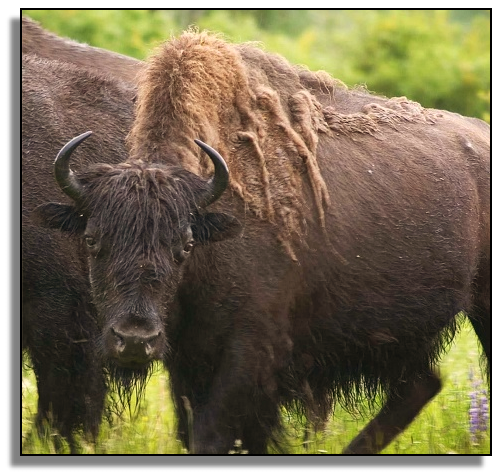
Example:
Restoring Wood Bison in Alaska  Wood
bison differ slightly from the plains bison that once roamed south
of Canada. By the 1940s, they were considered extinct. Then, in
1957, about 200 wood bison were discovered in a remote area of Wood
Buffalo National Park, Canada. Wood
bison differ slightly from the plains bison that once roamed south
of Canada. By the 1940s, they were considered extinct. Then, in
1957, about 200 wood bison were discovered in a remote area of Wood
Buffalo National Park, Canada.As part of a bi-national conservation program, wood bison have recovered substantially. Alaska began its restoration in 2003 and 2008. Sixty-six wood bison, mostly from Elk Island National Park, Alberta were brought to the Alaska Wildlife Conservation Center in Portage. The captive herd grew as Alaskans wrangled over if and where to release them to the wild. Finally in 2015, 130 wood bison were released in the Innoko/Yukon River area, near the small Athabascan community of Shageluk. During the year after release, 22% of wood bison died as the once-captive herd adjusted to the wild. Now that nature has selected the strongest animals, there have been fewer deaths. Most fatalities have been drownings, as bison broke through ice in beaver ponds. Some poaching occurred. There has been no evidence of disease. After declining during their first year in the wild, the herd began to grow. There were about 140 bison in June 2017. Average body condition (size and fat reserves) of the wild bison now exceed average condition measured when the herd was in captivity. Twenty-five calves were born in 2017 and 88% survived their first 6 months of life. Most of the wood bison have stayed within 50 miles of their release site, though a few have gone exploring. Biologists predict the herd will grow at an accelerating rate. Once hunting begins, bison restoration will bring meat to household tables locally and statewide. With hunter spending contributing to local economies, experts predict that the return on investment from the herd will be around 120 million dollars over 50 years. Although wood bison in Alaska are not plains bison in Montana, and management issues will differ, the Innoko/Yukon River wood bison restoration project demonstrates opportunities for bison restoration on and near the Charles M. Russell National Wildlife Refuge. In this project, the bison responded well to “rewilding”. Excerpted from Wood Bison News 10, 2018. |
Site designed and maintained by Kathryn QannaYahu Kern